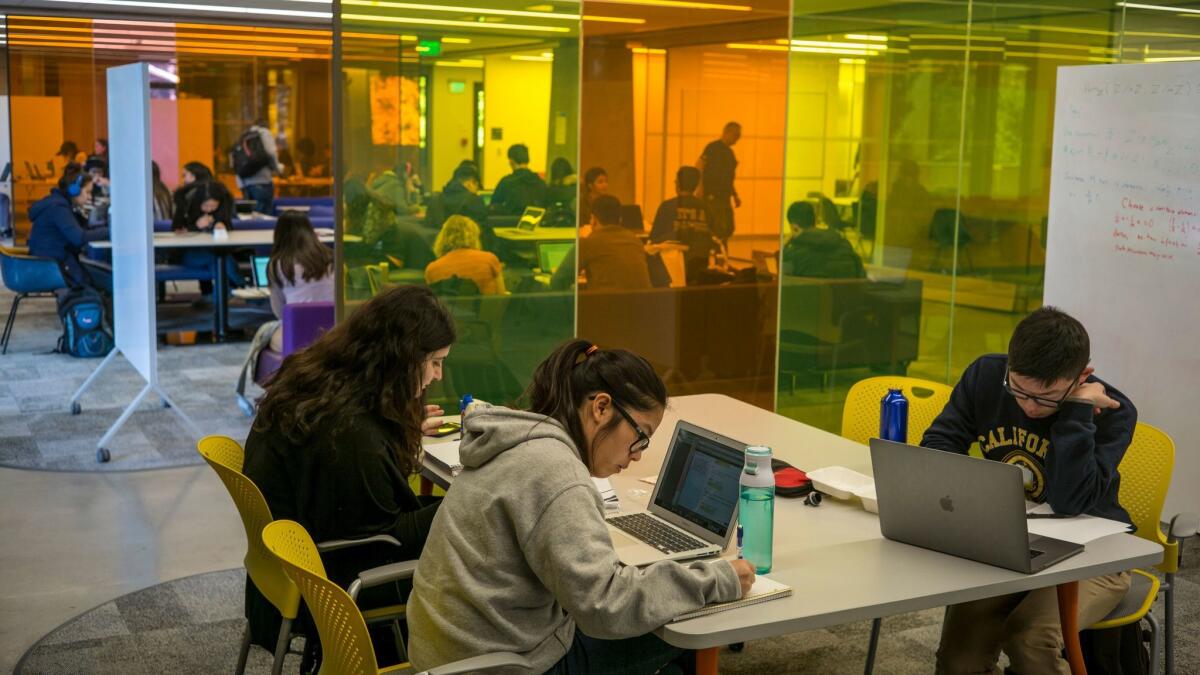UC revises its plan to limit the share of spots going to out-of-state students

The University of California, aiming to end fighting over how many out-of-state students it admits, on Tuesday announced a revised proposal to limit non-Californian and international undergraduates.
Under the proposal, UC would restrict the percentage of nonresident students to 18% at five of its nine undergraduate campuses. UC Berkeley, UCLA, UC San Diego and UC Irvine â whose proportion of nonresident students exceeds 18% â would be allowed to keep, but not increase, those higher percentages.
The new plan is a retreat from the proposal for a 20% systemwide cap on nonresident students that university officials presented to the UC Board of Regents in March. The cap, which would have been the first of it its kind, drew so much dissension from faculty and lawmakers that it was pulled from action and a vote was delayed until this month.
UC has faced much criticism from California families who think the university gives spots to out-of-state students at the expense of those who live here. State lawmakers threatened to block more funding if UC didnât put a nonresident policy in place. But many faculty members said a limit would deprive schools of both money and top college applicants.
UC spokeswoman Dianne Klein called the revised policy a âconsensus decisionâ reached after extensive discussions. Should the regents approve the policy at their May 18 meeting in San Francisco, lawmakers likely would release $18.5 million in state funding to help enroll an additional 2,500 California undergraduates for the 2017-18 school year.
âAt the first regents meeting, it was obvious there wasnât a consensus,â Klein said. âWe felt it was in everybodyâs interest to continue discussions over what would be the best path to enhance the enrollment of California residents, while still allowing campuses to enroll qualified nonresident students.â
Last fall, nonresident students numbered 34,673 â 16.5% of the systemâs 210,170 undergraduates. Their proportion varies widely by campus, ranging from 24.4% at UC Berkeley to less than 1% at UC Merced, the systemâs youngest and smallest university.
Campuses are eager to enroll students from other states and countries for both the diversity and extra tuition dollars they bring. They pay about $27,000 more in annual tuition than Californians â money that UC officials say has helped campuses recruit and retain faculty, add courses to reduce the overall class sizes and purchase library materials, instructional equipment and technology. The nonresident revenue also has boosted financial aid for Californians by an average $700 per student, Klein said.
As campuses scrambled to find extra money to offset deep state funding cuts after the 2008 recession, many actively recruited students from outside the state. Between 2007 and 2016, UC quadrupled its nonresident students. Even so, that percentage is lower than the average 27.9% for the 62 members of the elite Assn. of American Universities.
The number of California resident students increased by 10% during that time.
But the rapid growth in nonresident students, especially at flagships UC Berkeley, UCLA and UC San Diego, sparked a backlash from California families and lawmakers who believed they were squeezing out local children. A highly critical state audit last year concluded that UC had hurt California students by admitting too many nonresidents, although UC President Janet Napolitano labeled the findings âunfair and unwarranted.â
Assemblyman Kevin McCarty, D-Sacramento, has been a leading critic of the increase in nonresident students but said this week he was generally pleased with the revised proposal. If the regents approve it, he said, he would support the release of the $18.5 million in additional funds for UC.
âI would have liked to have gone back to 10% but Iâm not sure thatâs realistic,â McCarty said. âThis is a compromise in the middle.
Under an agreement between Napolitano and the state, UC enrolled an additional 7,400 Californians last fall â the largest single-year expansion since World War II â and officials hope to enroll an additional 5,000 over the next two years, in exchange for more state funding.
The latest proposal to limit nonresident students drops the idea of the systemwide cap, which some university officials worried might unfairly disadvantage campuses with fewer out-of-state and international undergraduates. James Chalfant, chair of the UC Academic Senate, had voiced concerns at the regents meeting in March that a systemwide cap would create a âtieredâ system in which the more popular campuses would enjoy the benefits of more tuition money.
Chalfant said the Senate was happy that the cap was dropped. But he said faculty members considered the debate an exercise in âhaggling over arbitrary percentagesâ rather than a serious conversation about how to support UC with enough dollars to maintain its vaunted excellence.
âA conversation about a funding strategy that preserves both access and excellence is long overdue and should start the moment this policy is adopted,â he said in an email.
The revised proposal would allow UC Davis, UC Santa Barbara, UC Santa Cruz, UC Riverside and UC Merced to increase nonresident students up to 18% of undergraduates on their campuses. The other four campuses that exceeded that limit last fall â UC Berkeley at 24.4%, UC San Diego at 22.9%, UCLA at 22.8% and UC Irvine at 18.9% â would be allowed to keep but not increase the higher percentages of nonresidents they are expected to enroll in the 2017-18 academic year.
The revised proposal reiterates that every eligible California student will be offered a spot on at least one UC campus and that nonresident undergraduates are âin addition to rather than in place ofâ Californians.
Campuses still could increase out-of-state students if they also increased Californians proportionately. But most campuses are squeezed for space for housing, classrooms and labs after the major enrollment boosts of the last year.
UCLA Chancellor Gene Block has said he has no plans to increase the share of nonresident students. Still, in an interview in March, Block said the additional tuition from students outside the state had made a âhuge differenceâ and allowed UCLA to provide more lecturers, teaching assistants and services that helped students graduate more quickly.
UC Irvine also appears to be satisfied with its share of nonresident students. âWeâve reached a comfort zone,â spokesman Tom Vasich said.
To read the article in Spanish, click here
Twitter: @teresawatanabe
More to Read
Sign up for Essential California
The most important California stories and recommendations in your inbox every morning.
You may occasionally receive promotional content from the Los Angeles Times.











